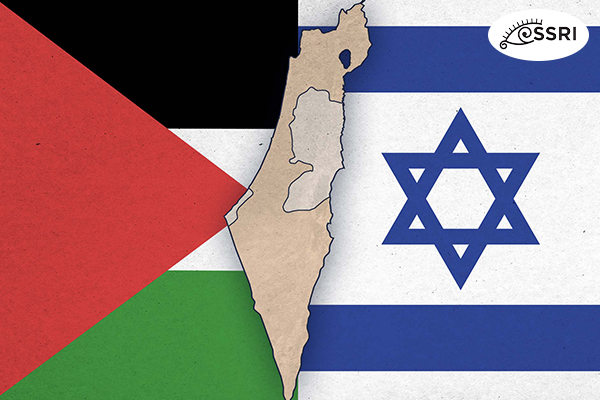Escalation of the Israeli-Hamas Conflict: The Deadliest Phase Yet
Since October 7, the conflict between Israel and Hamas has reached its most deadly phase. On that day, Hamas gunmen launched a devastating attack from Gaza into southern Israel, resulting in 1,200 Israeli deaths and the taking of 253 hostages, according to Israeli sources.
In retaliation, Israel initiated a military offensive against Gaza, which has led to over 40,400 Palestinian deaths, as reported by Gaza health authorities. This escalation marks the bloodiest chapter in the ongoing Israeli-Palestinian conflict, a struggle that has continued for over seventy years and continues to destabilize the Middle East.
Origins of the Israeli-Palestinian Conflict: Competing Claims for Homeland and Statehood
The roots of the Israeli-Palestinian conflict lie in the competing demands for land and sovereignty: Israel’s quest for a secure homeland in a historically hostile region, and Palestinians’ enduring struggle for statehood.
In 1947, while Palestine was under British mandate, the United Nations General Assembly proposed a partition plan to divide the land into separate Arab and Jewish states, with Jerusalem under international control. Jewish leaders accepted the plan, which allocated 56% of the territory to the Jewish state. However, the Arab League rejected the proposal, setting the stage for decades of conflict.
Birth of Israel: Founding Amid Conflict and Regional Opposition
On May 14, 1948, David Ben-Gurion, Israel’s founding father, declared the establishment of the modern state of Israel, just one day before the end of British rule.
This new state aimed to be a safe haven for Jews escaping persecution and seeking a homeland in a region to which they have ancient historical ties. Leading up to Israel’s creation, tensions and violence had been escalating between the Jewish and Arab populations, with Arabs comprising about two-thirds of the region’s inhabitants. The day after Israel’s declaration of independence, five Arab nations launched a military invasion, igniting the first Arab-Israeli war.
The Aftermath of War: The Palestinian Exodus and Ongoing Conflict
During the ensuing war, approximately 700,000 Palestinians fled or were expelled from their homes, seeking refuge in neighboring Jordan, Lebanon, Syria, Gaza, the West Bank, and East Jerusalem. This mass displacement, known as the “Nakba” or catastrophe by Palestinians, remains a deeply painful chapter in their history.
Israel disputes claims of forced expulsion. Although fighting ceased in 1949 with armistice agreements, no formal peace was achieved. Today, descendants of the Palestinians who remained during the war make up about 20% of Israel’s population.
Key Conflicts in the Ongoing Israeli-Palestinian Struggle
Since its establishment, Israel has been involved in several major conflicts with its neighbors and Palestinian groups:
- Six-Day War (1967): Israel launched a pre-emptive strike against Egypt and Syria, capturing the West Bank and Arab East Jerusalem from Jordan, the Golan Heights from Syria, and the Sinai Peninsula and Gaza Strip from Egypt. At the time, Gaza had a population of 394,000, with at least 60% being Palestinian refugees and their descendants.
- Yom Kippur War (1973): Egypt and Syria launched a surprise attack on Israeli positions along the Suez Canal and the Golan Heights. Israel managed to repel both armies within three weeks.
- Lebanon Invasion (1982): Israel invaded Lebanon, leading to the evacuation of thousands of Palestine Liberation Organization (PLO) fighters under Yasser Arafat after a ten-week siege. Israeli troops eventually withdrew from Lebanon in 2000.
- Gaza Withdrawals and Hamas Takeover (2005-2007): In 2005, Israel removed settlers and soldiers from Gaza. Hamas won parliamentary elections in 2006 and took full control of Gaza in 2007. Subsequent conflicts with Palestinian militants occurred in 2006, 2008, 2012, 2014, and 2021.
- Hezbollah War (2006): Following Hezbollah militants’ capture of two Israeli soldiers, Israel launched military operations, leading to a six-week war with Lebanon.
- Palestinian Intifadas: The first intifada occurred from 1987 to 1993, and the second from 2000 to 2005. During the second intifada, Hamas and other militant groups carried out suicide bombings in Israel, while Israel responded with tank assaults and airstrikes on Palestinian cities.
Since then, multiple rounds of hostilities have erupted between Israel and Hamas. Hamas does not recognize Israel and is classified as a terrorist organization by Israel, the European Union, the United States, and other countries. Hamas asserts that its armed activities are a form of resistance against Israeli occupation.
Efforts and Challenges in Pursuing Peace Between Israel and Palestine
Several notable attempts have been made to resolve the Israeli-Palestinian conflict:
- Egypt-Israel Peace Treaty (1979): Egypt became the first Arab state to sign a peace treaty with Israel, leading to the return of the Sinai Peninsula to Egyptian control.
- Oslo Accords (1993): Israeli Prime Minister Yitzhak Rabin and PLO leader Yasser Arafat signed the Oslo Accords, which established limited Palestinian autonomy in the West Bank and Gaza.
- Jordan-Israel Peace Treaty (1994): Israel and Jordan signed a peace treaty, furthering regional normalization efforts.
- Camp David Summit (2000): A summit at Camp David with Arafat, Israeli Prime Minister Ehud Barak, and U.S. President Bill Clinton failed to produce a final peace agreement.
- Arab League Plan (2002): The Arab League proposed a plan offering normal relations with Israel in exchange for a complete withdrawal from territories occupied in the 1967 war, the establishment of a Palestinian state, and a solution for Palestinian refugees. This plan was overshadowed by a Hamas attack on an Israeli hotel.
- Abraham Accords (2020): Under U.S. President Donald Trump, Israel normalized relations with several Arab states, including the United Arab Emirates, Bahrain, and Morocco. However, peace negotiations with Palestinians faltered after Trump’s recognition of Jerusalem as Israel’s capital, which Palestinians oppose as they seek East Jerusalem for their future state.
- Recent Mediation Efforts: Qatar and Egypt have played mediation roles in the latest conflict, securing a temporary truce in late 2023 that included a prisoner exchange and increased humanitarian aid to Gaza.
Current Status of Peace Negotiations in the Gaza Conflict
Efforts to secure a lasting truce in Gaza have stalled, with months of negotiations failing to achieve significant progress. As of May 10, Hamas reported that talks had reverted to square one, and by June 29, senior Hamas official Osama Hamdan confirmed that no advancements had been made since then.
Key challenges include Israel’s demand for the dismantling of Hamas as a precondition for peace, while Hamas insists on a permanent ceasefire rather than a temporary agreement. Disputes continue over the sequence of reciprocal measures, the release of Palestinian prisoners alongside Israeli hostages, control of the Gaza-Egypt border, and freedom of movement for Palestinians within Gaza.
U.S. President Joe Biden’s administration has proposed a comprehensive Middle East agreement, potentially involving normalization of relations between Israel and Saudi Arabia. However, Saudi Arabia has indicated that progress toward establishing an independent Palestinian state is a prerequisite for such normalization—a condition that Israeli Prime Minister Benjamin Netanyahu has dismissed.
Core Issues in the Israeli-Palestinian Conflict
The Israeli-Palestinian conflict revolves around several key issues:
- Two-State Solution: The proposed agreement aims to establish a Palestinian state alongside Israel, encompassing the West Bank and Gaza. However, Israeli Prime Minister Benjamin Netanyahu insists on maintaining security control over all territory west of the Jordan River, which would impede the creation of a fully sovereign Palestinian state.
- Settlements: Jewish settlements established on land captured by Israel in 1967 are considered illegal by most countries. Israel disputes this classification, citing historical and biblical connections to the land. The expansion of these settlements continues to be a major point of contention among Israel, the Palestinians, and the international community.
- Jerusalem: Palestinians seek East Jerusalem, including the Old City’s sacred sites, as the capital of their future state. Conversely, Israel insists that Jerusalem should remain its “indivisible and eternal” capital. International recognition of Israel’s claim to East Jerusalem is limited. Former U.S. President Donald Trump recognized Jerusalem as Israel’s capital and relocated the U.S. Embassy there in 2018, but did not clarify the extent of Israeli jurisdiction in the city.
- Refugees: Approximately 5.6 million Palestinian refugees, primarily descendants of those who fled in 1948, reside in Jordan, Lebanon, Syria, the Israeli-occupied West Bank, and Gaza. Many of these refugees live in overcrowded camps, with about half remaining stateless. Palestinians demand the right of return for refugees and their descendants, while Israel asserts that any resettlement must occur outside its borders.
Summary:
The conflict between Israel and Hamas has reached its deadliest phase since October 7, following a major attack by Hamas militants from Gaza into southern Israel. This assault resulted in over 1,200 deaths and 253 hostages being taken. In retaliation, Israel’s military campaign in Gaza has resulted in more than 40,400 Palestinian deaths, marking the bloodiest chapter in the prolonged Israeli-Palestinian conflict, which has endured for over seventy years and continues to destabilize the Middle East.




